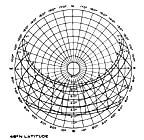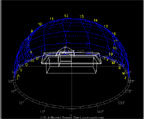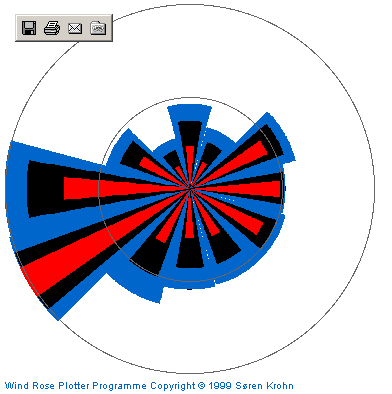Fall 2002 Gary Austin gaustin@uidaho.edu
| Winter Sun Path |
|
| Summer Sun Path |
 |
Solar Path Diagrams |
|||||||||||
| Solar Path Diagram 48 Degrees
This diagram would be used for Moscow since we are at about latitude 46.8N at latitude 116.7W. It is used to plot the position of the sun and provide azimuth (bearing in this case) and altitude. Note than the makers of various diagrams each create a slightly different graphic system.
|
 |
||||||||||
Definition of the Sun's Position (Azimuth and Altitude Angles)For a certain location, for a certain day and hour, azimuth and altitude angles may be defined by the following procedure. For this purpose the sun path diagram prepared for this location should be used. Example : Define the position of the sun in a town near latitude 36 at 9:00 am of December 21.
Solar Path Animation |
 |
||||||||||
| New software tools allow more accurate calculation of sun position and three dimensional representations of the path at various time of day and year. |
 |
||||||||||
|
One such tool is available at the Weather
Tool site. Sun angle calculator on the web |
|||||||||||
| Building Shape and Orientation for Energy Conservation | |||||||||||
|
Rectangular: 1:1.6 proportion Orient long façade toward south 17 ½ degrees east of south for temperate climates
|
|||||||||||
|
The building design proposal illustrated in these sections is based on the use of a sun path diagram created by the Libbey Owens Ford company. It is a more complex tool that provides profile angles, solar incidence and day-lighting information not available on the simpler diagrams that we have studied. We will spend more time using this system once we have preliminary
building footprints on our West Farm Project. The instructions on
the use of the Sun Angle Calculator is provided on line at |
|
||||||||||
|
|
|||||||||||
Wind |
|||
|
Weather stations data at the University of Idaho
Search for "Inside Idaho" Jan Feb Mar Apr May Jun Jul Aug Sep Oct
Nov Dec Ann |
|||
| Weather stations collect wind direction and speed
data. Most airports have on-site weather stations and are a good
source of local information.
Data on wind is often presented in tabular form but a "wind rose" diagram is especially useful and readable by visual thinkers
|
|||
|
|||
| Weather data |
| Average High JAN FEB MAR APR MAY JUN JUL AUG SEP OCT NOV DEC YEAR 35.6 41.3 49.0 57.5 65.9 73.1 82.6 84.0 74.4 60.5 43.1 35.5 58.5 |
| Average Low JAN FEB MAR APR MAY JUN JUL AUG SEP OCT NOV DEC YEAR 23.2 26.8 31.2 35.4 40.6 45.2 48.4 48.7 42.9 36.0 29.9 23.6 36.0 |
| Monthly Precip JAN FEB MAR APR MAY JUN JUL AUG SEP OCT NOV DEC YEAR 2.99 2.52 2.57 2.52 2.62 1.87 1.12 1.19 1.28 2.01 3.54 3.14 27.37 |
|
|





